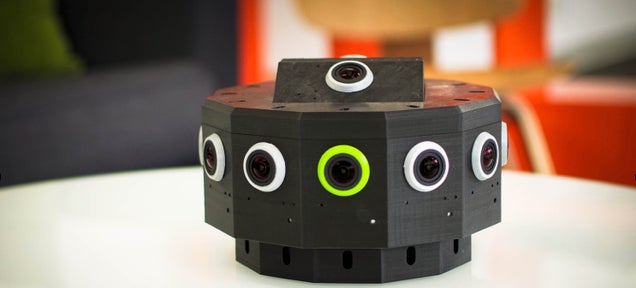
Gamers love Oculus Rift; the virtual reality system offers a mind-blowingly immersive way to experience digital worlds. Jaunt, a new tech company, brings the platform into live-action, cinematic territory. I saw their stuff. It was incredible. And it’s a Pretty Big Deal for movies and media.
Jaunt is an all-inclusive toolkit for directors and videographers to record real-life footage in 360-degree, 3D video and audio, which is then viewable on a VR platform like Oculus or Sony’s Morpheus. Or in other words, it’s a badass 3D camera.
This is not CG. It is not some average panorama photo stitchery, where a single lens sweeps around and records what it sees. Here, the camera acts as a proxy for you, and allows you to experience video via VR goggles as if you are part of the scene.
The idea behind Jaunt started with a question: is it possible to document an experience—say, a family trip to Death Valley—in something more in-depth than snapshots and clips? In the span of a year, the folks at Jaunt managed to make a device that took that initial concept to a functioning prototype.
First, they bought a Oculus dev kit off Craigslist (yes really) to better understand the platform Then, they built the initial Jaunt capture model out of Legos. Yes, really. It was rudimentary, but it worked.
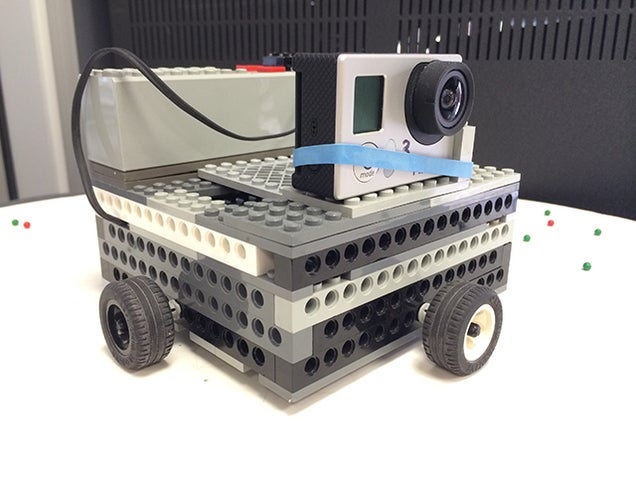
This little guy turns around on wheels and records everything around it.
Next, they began sourcing off-the-shelf items from Amazon and Frye’s combined with 3D-printed parts to make a more refined, next-gen upgrade. Impressive and more functional than ever, it wasn’t particularly practical to drag around.
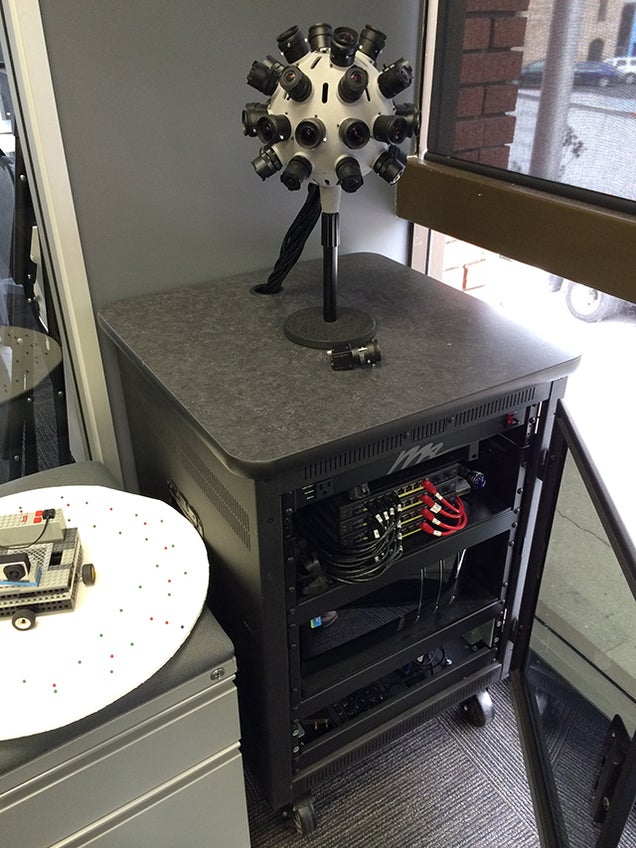
Pretty tough to lug this around and get the footage you want. The round sphere on top—which was 3D-printed, natch—studded in power-over-ethernet cameras that reminded me of Hellraiser.
Eventually, they ended up with a prototype that looks a lot like this.

The closest prototype to the real deal that they let me photograph, with lights and a 3D microphone flanking the camera lenses.

A close-up of the 3D microphone that allows for 3D spacialized audio. If you’re wearing headphones, there’s actually headtracking for the Oculus to tell which direction you’re looking—when you change your view, the sound mix will also change to match, in order to keep the sound in the same space.
As for what’s going on behind the scenes, the folks at Jaunt use the capture and processing capabilities of computational photography to extract 3D effects from multiple images. But Jaunt plays the specifics how how that all works precisely a little closer to the chest. The basic premise though, is pretty self-explanitory: an array of cameras and microsphones slurping up visual and audio data in 3D-space for VR playback at your leisure. And details aside, the proof is in the pudding.
So what’s it like to see something made with this?
Like all VR, you really have to see it to believe it, but here’s a rough approximation using just boring old words:
On Monday afternoon—a grey, rainy day in the Bay Area—I walked up the stairs of an unremarkable building at the end of Palo Alto’s charming University Street into a small, open-plan office. I said hello and shook hands with Jens Christensen, Arthur van Hoff, and Tom Annau—Jaunt’s founders—and we smiled and talked briefly about the crummy weather. Then I was led into a very dark, dramatically lit room outfitted with strategically placed speakers, sound absorption panels, a laptop, and a single green task chair.
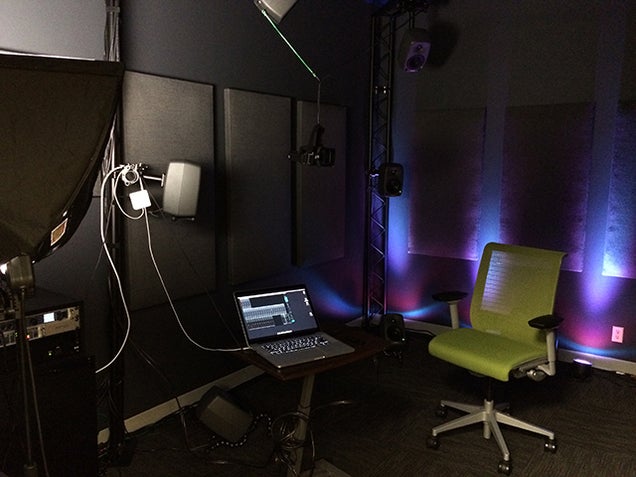
Not in the least bit freaky.
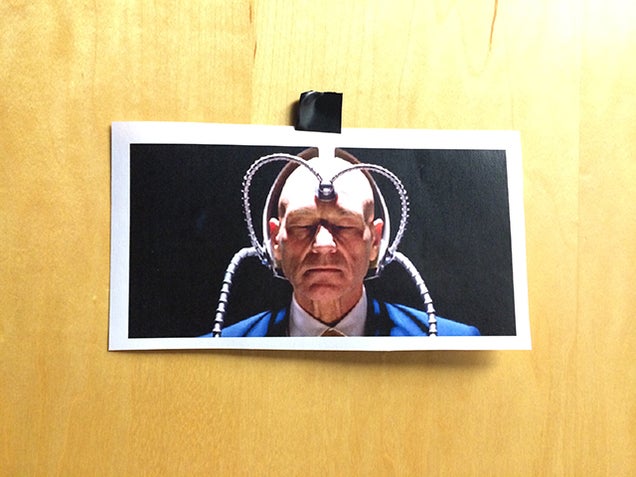
This was taped to the door.
I was asked to sit down, and was given a pair of Oculus HD goggles that were hanging from a cord suspended from the ceiling. I was handed a pair of headphones. At this point, everything was black and completely silent. I was only slightly anxious. And then they pressed play.
Immediately I was standing directly in the middle of a skate park. The sun was shining. There was a guy going back and forth over the shallow peaks and valleys directly to my right. There was no break in the scene as I looked left, and up, and all the way around behind me, and the sound remained true to the direction of his wheels along the concrete. This was a very real—like, shockingly real—3D transportation. It was a mouth agape, I-can’t-stop-giggling-out-of-pure-incredulity kind of leap.
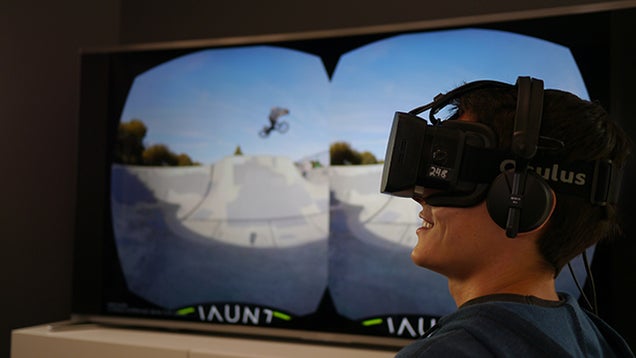
Not actually me, unfortunately—this is just a press pic, but that’s the skate park I saw. I forgot to have them take pics while I was wearing the goggles, but I assure you I looked just as jazzed—if not more!—to be there.
Then everything went black again.
All of a sudden I was on the patio of a beautiful villa. Dave Mustaine—yes, the dude fromMegadeth—was sitting on a chaise right in front of me, strumming on an acoustic guitar. A crystal clear swimming pool was glinting and gurgling on my left, and all around were the lovely trappings of a perfect California getaway (turns out it’s his home in San Diego). The notes he played synthesized with the sound of the water as if they were happening in real time, and again, the sun was out in full force. It was a recording—I know that—but it felt so true.
There were seven scenes like this—a girls’ choir singing in a circle surrounding me in the middle of a church, their notebooks strewn under chairs that had been pushed back to make room for the group; Shaolin monks training in a grassy field, getting closer to me from every direction; a woodsy overlook of the Golden Gate Bridge, punctuated by the chatter of a few surrounding tourists and a gentle coastal breeze; a low-budge creature feature in what appeared to be a submarine, complete with monsters coming out of hatches—and I was inside each one, in precisely the same way you can look around you right now and take in your immediate surroundings.
And then it was over. I took off the goggles and started laughing. Because it was awesome. And totally surreal. And very, very cool.
So, what’s the big deal?
When I told our resident Oculus expert Eric Limer that I was testing this out but hadn’t actually tried Oculus before, he told me not to worry: “Not many people have.” Which is the cruel irony; there’s no real way to convey just how real this feels without strapping a pair of goggles to your face other than to just say it repeatedly.
If Facebook buying Oculus for a cool $2 billion is a step towards democratizing the currently-niche platform, Jaunt seems like an equally monumental step towards making making awesome virtual reality content that appeals to folks beyond the gaming community. The VR movies in addition to VR games.
I mean, the implications are staggering. For example: A few weeks ago I had a chat with Charles Howell, senior producer at Framestore, the VFX masters who turned Alfonso Cuaron’s incredible vision for Gravity into a cinematic masterpiece. He said one of things they were most excited about working with was the burgeoning virtual reality scene (the company recently worked on the Game of Thrones experience).
Can you imagine seeing a version of Gravity where the action wasn’t just taking place on a screen in front of you, but in every single direction? Where you could view the same footage an infinite number of times and still catch details you’d never seen before, simply because you turned your head ever-so-slightly—or all the way around, or up, or down—and shifted your perspective? No one will ever view the exact same cut of the exact same footage; it is completely personalized based on where you look at any given moment. That and it’s totally immersive. It’s a revolutionary idea, but not without its challenges.
For one, in a regular movie, you can see when a baddie sneaking up on a main character comes into the frame. The artist has control. But with VR films, a baddie could be sneaking up on you—you just wouldn’t know it unless there was a cue, either audio or visual, to turn around. It’s suddenly less a story being dictated to you, and more a world you can find a story in.
And of course there’s the caveat of how to make the tech accessible. VR provides a uniquely solitary experience because it demands you don some (hard to come by) goggles, and immersive awesomeness doesn’t come across too great in pictures. I can’t tell you how much I want to show you what I saw, but it just ain’t gonna happen unless you have a pair of goggles too. For now, there are ways to view some of Jaunt’s trials on iOS devices—I checked out the Shaolin monks on an iPad in the office—but it doesn’t even remotely compare. In fact it’s such a poor substitute, that they’re keeping it under wraps for now.
I can’t cop to having the same—or any—emotional ties to Oculus that many who invested in the company’s Kickstarter campaign. But going in cold and experiencing just a taste of what Jaunt can offer in terms of a cinematic experience, I can say that we’re in for an incredible, and incredibly exciting, sea change for modern media. It definitely won’t be immediate, but if it can figure out a way to scale, it will be huge. In the immortal words of Martin Lawrence: Shit just got real.
Source: http://gizmodo.com/meet-the-crazy-camera-that-could-make-movies-for-the-oc-1557318674



